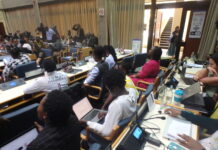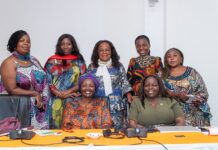By Mary Mwendwa
Nairobi, Kenya: Four young women have started developing an application that connects deaf children to the world through animated sign language. Through interactions with deaf people , they decided to come up with an innovation that would see children with hearing disabilities learn sign language.
Nancy Wagi, Ann Karau, Penina Waturi, and Susan Thuo worked for different organizations and were also friends with deaf people. This interest lead them to engage with sign language associations to learn sign language.
They teamed up and started working on an application using animation loaded on a tablet or phone for easy sign language learning. “Deaf children are always disconnected from society because of the language barrier. Usually, there are no classes for preschool children on sign language which is critical in their development as it is their only way of communication.” Notes Wagi.
This application is useful to deaf children because it connects them to the world of sign language through animation. They are able to start learning sign language at a tender age.

The UN Convention on human rights recognizes sign language as a human right that every deaf person should be able to access. Sadly, this has not been the case in many African sets – up. Deaf people especially children continue to be locked and secluded by society just because they cannot communicate with others. The few who access sign language get lucky to pursue their dreams in life.
The world health body says that 360 million people have disabling hearing loss globally, out of – whom 328 million are adults while 32 million are children. The Kenya National Survey on Deafness conducted in 1995 in 30 districts reported that between five and eight percent of the population has a hearing impairment.
In Kenya, deaf education makes up part of the ministry of education under the special education division. The Educational Assessment and Resource Services (EARS) also plays a role in assisting deaf education opportunities. It hosts an Educational Assessment and Resource Centre (EARC) in every Kenyan district. Before a deaf child is entered into a school, he is assessed at his local EARC.

Wagi, Thuo, Waturi, and Karau have always had a special attachment to people who are deaf. They have been working on different projects that target the deaf. Through their interaction with the deaf world, they saw a gap that led them to start a community-Based Organization called; Lugha Ishara (Sign Language).
This project saw them shortlisted for the Women in Technology Incubator 2019 initiative by the Standard Chartered and @IBizAfrica, Strathmore University win a seed funding of KES 1 million. They were shortlisted from over 170 applicants and will be incubated at Strathmore University for 9 months. They will be offered coaching, training, and business management skills to help them grow their business to the next level.
Lugha Ishara project which is at the start-up stage is expected to be a game-changer for children who are deaf. According to Wagi, “I realized the deaf were left out in many aspects of the society just because of the language barrier. I had to learn sign language when I came from Indonesia where I had interacted with deaf people and had challenges with sign language, In Kenya, I got to meet Susan and Ann whom we shared the same interests on deaf people.”
Wagi notes with a lot of concern that if the cognitive development process of a person is not developed at a young age it blocks them from realizing their full potential. She further says that inclusion for the deaf people should start at home, at a very tender age. “This is the reason why we started this project to target deaf children from 0 -5 years.”

On her part, Thuo who is part of the Lugha Ishara team believes that Sign language technology will be a connector to deaf children. “Our focus is to help them learn sign language at an early age to allow them to interact even with their parents and siblings at home.’’
Thuo confirms that the sign language learning application will be loaded on a smartphone or a tablet and have an animation that will help the deaf child and the rest of the family learn sign language at their comfort. “This tablet will come at a cost that will not be very expensive and loaded with the application. It will be solar-powered to help those who are not connected to the grid.”
She further reveals that they have started with a 2 D animation where they are working with animators to help create the application for use. “We cannot say at this moment what works best but we are in the process of creating content and this takes a long time because of the process involved.”
“For the last five months we have been asking ourselves critical questions around this project, initially we thought we will have few people involved and after we joined the incubator program at Strathmore we have realized there are many other people who will be involved that we had not thought of from the initial stages.” Says Thuo.
Wagi on her part believes that screening mothers before delivery can be a very good thing to detect deaf children. This is very helpful to allow the mother to start walking the journey early enough. “Many mothers get the shock after a child is born and mostly they start living in denial and creating a barrier to allow the child to realize the full potential in life.”
“Stigma is the biggest challenge for people who are deaf; it cuts across and starts from the family itself, tackling it needs a multidisciplinary approach,” Wagi says.
Thuo says that they are taking time to create content as it is a lengthy process. “We would rather take time to come up with content than come up with something that will not meet the expectations of people interacting with deaf children.”
One million seed funding comes handy for them because they have to use money in coming up with the application and also using an animator for the animation.
“For us, technology is a connector to children who are deaf, this technology will help parents and siblings interact with the deaf child at their own structure and at their own pace. It is a self-learning tool for sign language.” Thuo confirms.
Lugha Ishara has embraced inclusion by having a deaf co-founder known as Ann Karau. Her team believes that she is instrumental in helping tackling issues with the deaf.”
This application once completed will be available to people who have deaf children. With the tag line of Enjoy, Connect and relate, it will help more people living with deaf children learn sign language and create a change in deaf children.














